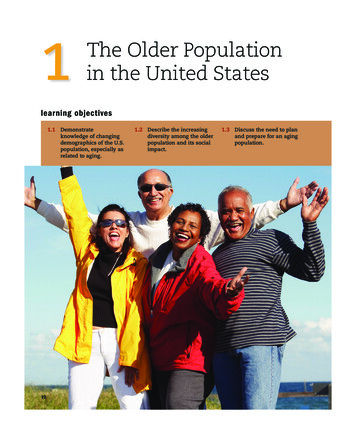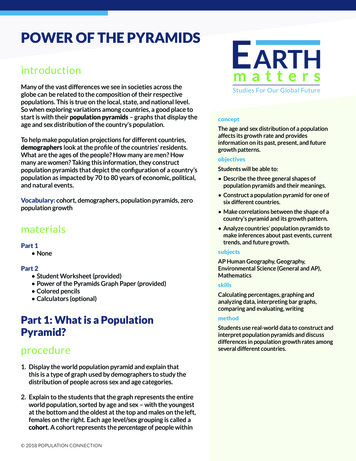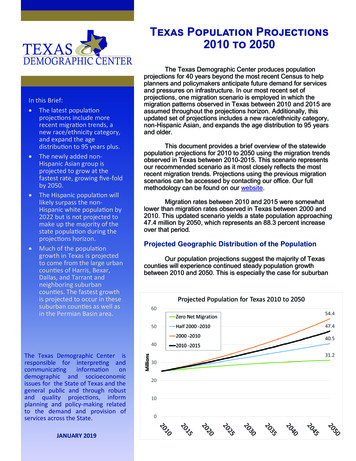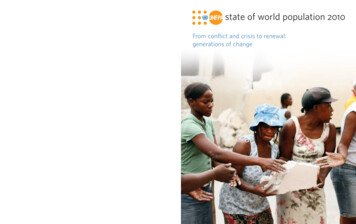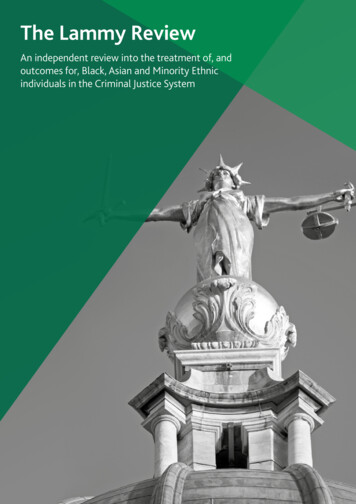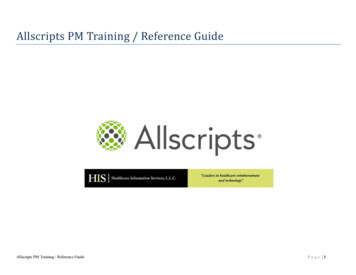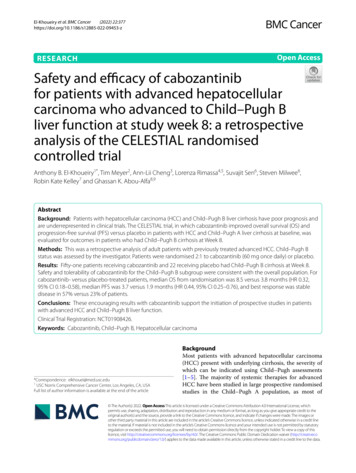
Transcription
(2022) 22:377El‑Khoueiry et al. BMC en AccessRESEARCHSafety and efficacy of cabozantinibfor patients with advanced hepatocellularcarcinoma who advanced to Child–Pugh Bliver function at study week 8: a retrospectiveanalysis of the CELESTIAL randomisedcontrolled trialAnthony B. El‑Khoueiry1*, Tim Meyer2, Ann‑Lii Cheng3, Lorenza Rimassa4,5, Suvajit Sen6, Steven Milwee6,Robin Kate Kelley7 and Ghassan K. Abou‑Alfa8,9AbstractBackground: Patients with hepatocellular carcinoma (HCC) and Child–Pugh B liver cirrhosis have poor prognosis andare underrepresented in clinical trials. The CELESTIAL trial, in which cabozantinib improved overall survival (OS) andprogression-free survival (PFS) versus placebo in patients with HCC and Child–Pugh A liver cirrhosis at baseline, wasevaluated for outcomes in patients who had Child–Pugh B cirrhosis at Week 8.Methods: This was a retrospective analysis of adult patients with previously treated advanced HCC. Child–Pugh Bstatus was assessed by the investigator. Patients were randomised 2:1 to cabozantinib (60 mg once daily) or placebo.Results: Fifty-one patients receiving cabozantinib and 22 receiving placebo had Child–Pugh B cirrhosis at Week 8.Safety and tolerability of cabozantinib for the Child–Pugh B subgroup were consistent with the overall population. Forcabozantinib- versus placebo-treated patients, median OS from randomisation was 8.5 versus 3.8 months (HR 0.32,95% CI 0.18–0.58), median PFS was 3.7 versus 1.9 months (HR 0.44, 95% CI 0.25–0.76), and best response was stabledisease in 57% versus 23% of patients.Conclusions: These encouraging results with cabozantinib support the initiation of prospective studies in patientswith advanced HCC and Child–Pugh B liver function.Clinical Trial Registration: NCT01908426.Keywords: Cabozantinib, Child–Pugh B, Hepatocellular carcinoma*Correspondence: elkhouei@med.usc.edu1USC Norris Comprehensive Cancer Center, Los Angeles, CA, USAFull list of author information is available at the end of the articleBackgroundMost patients with advanced hepatocellular carcinoma(HCC) present with underlying cirrhosis, the severity ofwhich can be indicated using Child–Pugh assessments[1–5]. The majority of systemic therapies for advancedHCC have been studied in large prospective randomisedstudies in the Child–Pugh A population, as most of The Author(s) 2022. Open Access This article is licensed under a Creative Commons Attribution 4.0 International License, whichpermits use, sharing, adaptation, distribution and reproduction in any medium or format, as long as you give appropriate credit to theoriginal author(s) and the source, provide a link to the Creative Commons licence, and indicate if changes were made. The images orother third party material in this article are included in the article’s Creative Commons licence, unless indicated otherwise in a credit lineto the material. If material is not included in the article’s Creative Commons licence and your intended use is not permitted by statutoryregulation or exceeds the permitted use, you will need to obtain permission directly from the copyright holder. To view a copy of thislicence, visit http:// creat iveco mmons. org/ licen ses/ by/4. 0/. The Creative Commons Public Domain Dedication waiver (http:// creat iveco mmons. org/ publi cdoma in/ zero/1. 0/) applies to the data made available in this article, unless otherwise stated in a credit line to the data.
El‑Khoueiry et al. BMC Cancer(2022) 22:377Page 2 of 10these trials excluded patients with poor liver function(Child–Pugh B or worse hepatic dysfunction). Further,underlying liver cirrhosis represents a competing risk ofdeath in patients with HCC and Child–Pugh B cirrhosis;therefore, the benefit of anticancer therapy is difficult toevaluate in non-randomised studies. Consequently, limited data are available for the use of systemic therapies inpatients with advanced liver cirrhosis, resulting in a lackof treatment options for this population [6–8].Cabozantinib is a tyrosine kinase inhibitor with targetsthat include MET, VEGFR, and the TAM family of receptor kinases and is approved for patients with HCC whohave been previously treated with sorafenib [9, 10]. Inthe pivotal phase 3 CELESTIAL trial (NCT01908426),cabozantinib, as second- or third-line therapy, significantly improved overall survival (OS) and progressionfree survival (PFS) versus placebo in patients withpreviously treated advanced HCC and Child–Pugh Aliver cirrhosis [11]. Median OS was 10.2 months withcabozantinib versus 8.0 months with placebo (hazardratio [HR] 0.76; 95% confidence interval [CI] 0.63–0.92;p 0.005), and median PFS was 5.2 months with cabozantinibversus 1.9 months with placebo (HR 0.44; 95% CI 0.36–0.52;p 0.001) [11].We present a post hoc retrospective evaluation ofthe safety and efficacy of cabozantinib in patients fromCELESTIAL with Child–Pugh A liver cirrhosis who progressed to Child–Pugh B cirrhosis at Week 8. The objective of this analysis was to characterise clinical outcomesin this cohort of patients.B virus [HBV], with or without hepatitis C virus [HCV];HCV without HBV; or non-viral), geographic region(Asia or other), and extrahepatic spread of disease, macrovascular invasion, or both (yes or no). The outcomesreported in this retrospective analysis are safety, withassessments starting from study initiation; OS; and investigator-assessed PFS and tumour response per RECISTv1.1. Overall survival was defined as the time from randomisation to death from any cause; progression-freesurvival was defined as the time from randomisation toradiographic progression or death from any cause, whichever occurred first; objective response rate was definedas the percentage of patients with a confirmed completeor partial response. Adverse events (AEs) were reportedaccording to National Cancer Institute Common TerminologyCriteria for Adverse Events v4.0 [12]. Radiographicassessment by computed tomography or magneticresonance imaging was conducted every 8 weeksafter randomisation with a follow-up assessmentconducted 8 weeks after radiographic progression ortreatment discontinuation. Safety was assessed continuously with a final assessment 30 days after treatment discontinuation. Patients who were Child–Pugh A at Week 8or patients who did not have a Child–Pugh assessmentat Week 8 were excluded from this retrospectiveanalysis; patients with Child–Pugh C status at Week 8were also excluded as cabozantinib should be avoidedin patients with severe hepatic impairment. The datacutoff date was 1 June 2017.MethodsThis is a retrospective analysis of outcomes from CELESTIAL for the subgroup of patients who had Child–Pugh Bcirrhosis, as assessed by the investigator, by Week 8 (timeof first Child–Pugh assessment and the first radiographicassessment after randomisation). Child–Pugh scoring wasalso independently determined retrospectively by theBiostatistics and Clinical Data Management (BCDM)department at Exelixis Inc. (study sponsor), based oninvestigator assessments for ascites and hepatic encephalopathyand central laboratory assessments. CELESTIAL study detailshave been previously published for the efficacy and safety resultsfor the overall population [11]. The study allowed adultpatients with advanced HCC, Child–Pugh class A liver function, and Eastern Cooperative Oncology Group performancestatus of 0 or 1 [11]. Patients must have received priorsorafenib and could have received up to two priorsystemic regimens [11]. Patients were randomised 2:1to receive cabozantinib 60 mg once daily or matchedplacebo [11]. Randomisation was performed with aninteractive response system and permuted blocks. Randomisation was stratified by disease aetiology (hepatitisPatient PopulationResultsAt randomisation, nearly all patients had investigator-assessedChild–Pugh class A cirrhosis, with seven patients in thecabozantinib arm and two patients in the placebo armassessed to have Child–Pugh B cirrhosis and notedas protocol deviations. Three out of a total of ninepatients with Child–Pugh B status at baseline hadWeek 8 data, with all being in the cabozantinib group;one remained with Child–Pugh B and two were assessedwith Child–Pugh A at Week 8. At the time of the firstChild–Pugh assessment at Week 8 after randomisation,51/470 patients in the cabozantinib arm and 22/237patients in the placebo arm had investigator-assessedChild–Pugh B cirrhosis (Child–Pugh B subgroup).Child–Pugh status at Week 8 was unknown for 288 patientsin the overall study population (194 for cabozantinib and94 for placebo), Child–Pugh A for 343 patients (223 and120), and Child–Pugh C for 3 patients (2 and 1); thesepatients were excluded from this retrospective analysis.Cabozantinib and placebo were received for 8 weeksby 94% (48/51) and 82% (18/22) of patients, respectively,for the Child–Pugh B cohort and 80% (375/467) and
El‑Khoueiry et al. BMC Cancer(2022) 22:37776% (135/237) of patients, respectively, for the overallpopulation. As of data cutoff, the percent (n) of patientswho were still on cabozantinib/placebo was 6% (3)/0 for theChild–Pugh B cohort and 16% (73)/11% (26) for the overallpopulation.For patients with investigator-assessed Child–Pugh B statusat Week 8, the majority (64%) had a BCDM-determinedChild–Pugh score of A6 at baseline and 27% had a Child–Pughscore of A5, whereas 7% had a score 7 and 1% of scoreswere missing (Table 1). Among those who still hadinvestigator-assessed Child–Pugh A cirrhosis at Week8, 26% (90/341) had BCDM-determined Child–PughA6 status and 72% (246/341) had A5 status at baseline.In the overall CELESTIAL patient population, 37% hadChild–Pugh A6 status and 59% had Child–Pugh A5status at baseline. At least half of the patients (51%) in theChild–Pugh B subgroup had a Child–Pugh score of 7at Week 8, whereas 19% and 11% had Child–Pugh scoresof 8 and 9, respectively (Table 2). Point changes from baseline in the levels of albumin, bilirubin, and ascites werethe most common contributors to the development ofthe Child–Pugh B status at Week 8 for patients in both thecabozantinib and placebo arms. At Week 8, greater changesfrom baseline were observed for the Child–Pugh B subgroupversus the overall population in various liver functionparameters, including liver enzyme activity (i.e., alkalinephosphatase), and albumin and bilirubin levels (Additionalfile 1, Table 1).Patients in the Child–Pugh B subgroup tended tohave higher baseline rates of albumin-bilirubin (ALBI)grades 2/3 compared with the overall study population(92% vs. 59%), macrovascular invasion (40% vs. 30%),and prior transarterial chemoembolisation for HCC(53% vs. 44%), whereas aetiology of hepatitis B virus(HBV) tended to be lower (33% vs. 38%) (Table 1). In theChild–Pugh B subgroup, patients in the cabozantinib armversus the placebo arm tended to have higher baseline rates ofmacrovascular invasion (43% vs. 32%), extrahepatic spread(82% vs. 68%), alpha-fetoprotein 400 ng/mL (39% vs. 27%),HBV (35% vs. 27%), and hepatitis C virus (31% vs. 18%).Additionally, for the Child–Pugh B subgroup, thecabozantinib arm in comparison with the placebo armtended to have a higher baseline rate of ALBI grade 1 (10%vs. 5%) and a lower rate of ALBI grade 2 (88% vs. 95%).Safety and TolerabilityFor patients assigned to cabozantinib, the median average daily dose (36.9 mg), the median duration of exposure (3.7 months), and the rates of dose reduction (61%)and discontinuation (18%) due to treatment-relatedAEs for patients in the Child–Pugh B subgroup weresimilar to the overall cabozantinib group (Table 3).Grade 3/4 all-causality AEs in the cabozantinib armPage 3 of 10were experienced by 71% of patients in the Child–Pugh Bsubgroup compared with 68% overall. The rates of themost common grade 3/4 AEs were numerically higherin the Child–Pugh B subgroup compared with the overall cabozantinib group for fatigue (20% vs. 10%), ascites(14% vs. 4%), and thrombocytopenia (12% vs. 3%) andlower for palmar-plantar erythrodysesthesia (8% vs. 17%)and hypertension (8% vs. 16%). Rates of grade 3/4 AEsassociated with liver toxicity were generally similarfor the Child–Pugh B subgroup compared with theoverall cabozantinib group, with rates comparable forincreased alanine aminotransferase (ALT) and aspartateaminotransferase (AST) and higher for increasedbilirubin (10% vs. 3%). The occurrence of grade 3/4 AEsassociated with cirrhosis decompensation was greater forthe Child–Pugh B subgroup than the overall cabozantinib groupfor ascites, indicated previously, and hepatic encephalopathy(6% vs. 3%).For patients assigned to placebo, 59% in the Child–Pugh Bsubgroup and 36% overall experienced grade 3/4 all-causalityAEs. Higher rates of Grade 3/4 AEs were reported in theChild–Pugh B subgroup relative to the overall placebo groupfor fatigue (18% vs. 4%) and ascites (23% vs. 5%), whereas rateswere comparable for increased ALT, AST, and bilirubin.Efficacy OutcomesIn the Child–Pugh B subgroup, median OS was8.5 months for patients receiving cabozantinib versus3.8 months for patients receiving placebo (HR 0.32, 95%CI 0.18–0.58) (Fig. 1A). Median PFS was 3.7 months withcabozantinib versus 1.9 months with placebo (HR 0.44,95% CI 0.25–0.76) (Fig. 1B). There were no complete orpartial responses in the Child–Pugh B subgroup. Stabledisease as a best objective response was obtained by 57% ofpatients in the cabozantinib arm versus 23% of patients inthe placebo arm of the Child–Pugh B subgroup (Table 4).These results are consistent with those reported for theoverall study population.For the overall study population, median OS was10.2 months with cabozantinib and 8.0 months withplacebo (HR 0.76; 95% CI 0.63–0.92), whereas medianPFS was 5.2 months with cabozantinib and 1.9 monthswith placebo (HR 0.44; 95% CI 0.36–0.52) and stabledisease was obtained by 60% and 33% of patients,respectively [11].DiscussionThis exploratory analysis evaluated the safety and efficacy of cabozantinib in patients from CELESTIALwhose liver function deteriorated to Child–Pugh Bstatus by Week 8 at the time of the first Child–Pughinvestigator assessment. A majority of these patientshad a Child–Pugh score of 6 at baseline, as determined
El‑Khoueiry et al. BMC Cancer(2022) 22:377Page 4 of 10Table 1 Baseline characteristics of Child–Pugh B subgroupOverall populationaChild–Pugh B subgroupCabozantinib Placebo(N 51)(N 22)Total(N 73)Cabozantinib(N 470)Placebo(N 237)Total(N 707)Median age (range), years63.0 (22–82)64.5 (50–85)64.0 (22–85)64 (22–86)64 (24–86)64 (22–86)Male, n (%)45 (88)20 (91)65 (89)379 (81)202 (85)581 (82)Asia14 (27)3 (14)17 (23)116 (25)59 (25)175 (25)Europe21 (41)12 (55)33 (45)231 (49)108 (46)339 (48)Australian/New Zealand1 (2)1 (5)2 (3)15 (3)11 (5)26 (4)Canada/USA15 (29)6 (27)21 (29)108 (23)59 (25)167 (24)Asian17 (33)5 (23)22 (30)159 (34)82 (35)241 (34)White30 (59)14 (64)44 (60)264 (56)130 (55)394 (56)Black02 (9)2 (3)8 (2)11 (5)19 (3)Other1 (2)1 (5)2 (3)8 (2)2 (1)10 (1)Not reported3 (6)03 (4)31 (7)12 (5)43 (6)027 (53)12 (55)39 (53)245 (52)131 (55)376 (53)124 (47)10 (45)34 (47)224 (48)106 (45)330 (47)20001 ( 1)01 ( 1)HBV18 (35)6 (27)24 (33)178 (38)89 (38)267 (38)HCV16 (31)4 (18)20 (27)113 (24)55 (23)168 (24)Alcohol use19 (37)4 (18)23 (32)112 (24)39 (16)151 (21)Nonalcoholic steatohepatitis3 (6)2 (9)5 (7)43 (9)23 (10)66 (9) 400 ng/mL31 (61)16 (73)47 (64)278 (59)136 (57)414 (59) 400 ng/mL20 (39)6 (27)26 (36)192 (41)101 (43)293 (41) 35 g/L27 (53)11 (50)38 (52)131 (28)60 (25)191 (27) 35 g/L24 (47)11 (50)35 (48)339 (72)177 (75)516 (73) 22.23 µmol/L40 (78)20 (91)60 (82)421 (90)221 (93)642 (91) 22.23– 29.07 µmol/L6 (12)2 (9)8 (11)37 (8)13 (5)50 (7) 29.07 µmol/L5 (10)05 (7)12 (3)3 (1)15 (2)47 (92)17 (77)64 (88)398 (85)200 (84)598 (85)Extrahepatic spread of disease42 (82)15 (68)57 (78)369 (79)182 (77)551 (78)Macrovascular invasion22 (43)7 (32)29 (40)129 (27)81 (34)210 (30)15 (10)1 (5)6 (8)186 (40)102 (43)288 (41)245 (88)21 (95)66 (90)282 (60)133 (56)415 (59)31 (2)01 (1)2 ( 1)2 (1)4 (1)513 (25)7 (32)20 (27)264 (56)153 (65)417 (59)633 (65)14 (64)47 (64)183 (39)78 (33)261 (37) 74 (8)1 (5)5 (7)17 (4)5 (2)22 (3)Missing1 (2)01 (1)6 (1)1 ( 1)7 (1)Liver45 (88)21 (95)66 (90)395 (84)216 (91)611 (86)Bone9 (18)2 (9)11 (15)60 (13)34 (14)94 (13)Geographic region, n (%)Race, n (%)ECOG status, n (%)Aetiology of disease, n (%)AFP, n (%)Albumin, n (%)Bilirubin, n (%)Extrahepatic spread of disease and/ormacrovascular invasion, n (%)ALBI grade, n (%)Child–Pugh score, n (%)bSites of disease, n (%)
El‑Khoueiry et al. BMC Cancer(2022) 22:377Page 5 of 10Table 1 (continued)Overall populationaChild–Pugh B subgroupCabozantinib Placebo(N 51)(N 22)Total(N 73)Cabozantinib(N 470)Placebo(N 237)Total(N 707)Visceral (excluding liver)24 (47)9 (41)33 (45)215 (46)105 (44)320 (45)Lymph node19 (37)3 (14)22 (30)155 (33)71 (30)226 (32)01 (2)01 (1)3 (1)03 ( 1)133 (65)13 (59)46 (63)335 (71)174 (73)509 (72)216 (31)9 (41)25 (34)130 (28)62 (26)192 (27) 31 (2)01 (1)2 ( 1)1 ( 1)3 ( 1)TACE for HCC, N (%)26 (51)13 (59)39 (53)203 (43)111 (47)314 (44)Median total duration of prior sorafenib(range), months5.4 (1.1–40.0)7.1 (1.0–29.2) 5.4 (1.0–40.0)5.3 (0.3–70.0)4.8 (0.2–76.8) 5.2 (0.2–76.8)Median time from disease progression torandomisation (range), m oc1.5 (0.2–100.8)1.9 (0.4–69.4) 1.5 (0.2–100.8) 1.6 (0–100.8)1.7 (0.2–69.4) 1.6 (0–100.8)Number of prior systemic anticancer regimensfor advanced HCC, n (%)aData from Abou-Alfa et al. N. Engl. J. Med. 379, 54–63 (2018) [11]. bAs Child–Pugh grading was investigator assessed and Child–Pugh scoring was determinedretrospectively by BCDM, some discrepancies between grading and scoring results existed. cn 49 and 21 for cabozantinib and placebo cohorts, respectively. AFPalpha fetoprotein, ALBI albumin-bilirubin, BCDM Biostatistics and Clinical Data Management, ECOG Eastern Cooperative Oncology Group, HBV hepatitis B virus, HCVhepatitis C virus, TACE transarterial chemoembolisationTable 2 Child–Pugh scores at Week 8Patients with Patients withChild–Pugh score (Week 8)Child–Pugh B availablen (%) bat Week 8, nBCDM-determined7 points 8 points 9 pointsChild–Pugh scorepoints, n aCabozantinib514226 (51)11 (22)3 (6)Placebo222111 (50)3 (14)5 (23)aTwo patients each in the cabozantinib and placebo cohorts had a score of 6.As Child–Pugh grading was investigator assessed and Child–Pugh scoring wasdetermined independently by BCDM, some discrepancies between grading andscoring results existed. bPercentage of total number of patients who developedChild–Pugh B cirrhosis. BCDM Biostatistics and Clinical Data Managementby BCDM, whereas most of the patients who still hadChild–Pugh A status at Week 8 had a Child–Pughscore of 5. Although investigator-assessed Child–Pughgrading and BCDM-determined Child–Pugh scoringwere done independently, the majority of determinations were concordant. Cabozantinib appeared to havea manageable safety profile in the Child–Pugh B subgroup, with comparable rates to the overall cabozantinib group for dose reductions and discontinuationsdue to treatment-related AEs [11]. However, there weredifferences in the rates of some grade 3/4 AEs, including higher rates of fatigue, ascites, and thrombocytopenia in the Child–Pugh B subgroup compared with theoverall cabozantinib group [11]. Higher rates of somegrade 3/4 AEs were also noted in the placebo arm forthe Child–Pugh B subgroup relative to the overall placebogroup. As these grade 3/4 AEs occurred throughoutthe study, their incidence could be associated withreduced liver function, the course of the disease, orboth. The higher incidence of thrombocytopenia withcabozantinib versus placebo in both the retrospectivecohort and the overall study population and the absenceof events in the placebo arm of the retrospective cohortcould indicate an association with cabozantinib treatment. These data are consistent with the expectedclinical manifestations of more advanced cirrhosis andportal hypertension [13–15], and suggest that patientswith Child–Pugh B cirrhosis are at greater risk ofexperiencing treatment-emergent or treatment-relatedAEs compared with patients with Child–Pugh A cirrhosis,which represents nearly all of patients in the overallpopulation.Hazard ratios for OS and PFS indicate clinical benefitwith cabozantinib in the Child–Pugh B subgroup. Theoutcomes with cabozantinib in patients with HCC andcompromised liver function presented here are alsosupported by the outcomes of a CELESTIAL subgroupanalysis based on baseline ALBI grades (an objectivemeasure of liver function with higher grades associatedwith worse prognosis [16]) [17]. In the analysis by ALBIgrade, a trend of improved OS and PFS with cabozantinibcompared with placebo was observed irrespective ofbaseline grade [17]. It should be noted that a majority ofpatients in the Child–Pugh B subgroup had ALBI grade2 cirrhosis at baseline.
El‑Khoueiry et al. BMC Cancer(2022) 22:377Page 6 of 10Table 3 Safety and tolerability of cabozantinib (safety population)Overall populationaChild–Pugh B subgroupMedian duration of exposure(range), monthsCabozantinib (N 51)Placebo (N 22)Cabozantinib (N 467)Placebo (N 237)3.7 (1.4–12.9)2.0 (0.9–5.5)3.8 (0.1–37.3)2.0 (0.0–27.2)56.8 (17.9–60.0)35.8 (1.1–60.0)58.9 (12.0–60.0)Median average daily dose (range), 36.9 (12.5–60.0)mgDose reduction, n (%)31 (61)3 (14)291 (62)30 (13)Discontinuation due totreatment-related AE, n (%)9 (18)1 (5)74 (16)6 (2.5)All-causality AE, n (%)bAny eventAny gradeGrade 3/4Any gradeGrade 3/4Any gradeGrade 3/4Any gradeGrade 3/451 (100)36 (71)22 (100)13 (59)460 (99)316 (68)219 (92)86 (36)Fatigue29 (57)10 (20)9 (41)4 (18)212 (45)49 (10)70 (30)10 (4.2)Ascites17 (33)7 (14)12 (55)5 (23)57 (12)18 (3.9)30 (13)11 (4.6)AST increased11 (22)7 (14)2 (9.1)1 (4.5)105 (22)55 (12)27 (11)16 (6.8)Thrombocytopenia11 (22)6 (12)0052 (11)16 (3.4)1 (0.4)0Anaemia6 (12)5 (9.8)5 (23)4 (18)46 (9.9)19 (4.1)19 (8.0)12 (5.1)Blood bilirubin increased11 (22)5 (9.8)3 (14)045 (9.6)14 (3.0)17 (7.2)4 (1.7)Dyspnoea10 (20)5 (9.8)7 (32)058 (12)15 (3.2)24 (10)1 (0.4)Blood ALP increased4 (7.8)4 (7.8)0034 (7.3)16 (3.4)14 (5.9)1 (0.4)Hypertension9 (18)4 (7.8)00137 (29)74 (16)14 (5.9)4 (1.7)PPE15 (29)4 (7.8)1 (4.5)0217 (46)79 (17)12 (5.1)0Platelet count decreased6 (12)4 (7.8)0045 (9.6)17 (3.6)7 (3.0)2 (0.8)Portal vein thrombosis4 (7.8)4 (7.8)006 (1.3)5 (1.1)00Pulmonary embolism4 (7.8)4 (7.8)007 (1.5)6 (1.3)5 (2.1)4 (1.7)Asthenia12 (24)3 (5.9)3 (14)0102 (22)32 (6.9)18 (7.6)4 (1.7)Decreased appetite30 (59)3 (5.9)5 (23)0225 (48)27 (5.8)43 (18)1 (0.4)Diarrhoea24 (47)3 (5.9)6 (27)1 (4.5)251 (54)46 (9.9)44 (19)4 (1.7)General physical health dete‑rioration5 (9.8)3 (5.9)2 (9.1)2 (9.1)33 (7.1)21 (4.5)11 (4.6)6 (2.5)Hepatic encephalopathy4 (7.8)3 (5.9)0019 (4.1)13 (2.8)3 (1.3)2 (0.8)Hyperbilirubinemia4 (7.8)3 (5.9)1 (4.5)011 (2.4)6 (1.3)8 (3.4)5 (2.1)Nausea23 (45)3 (5.9)6 (27)0147 (31)10 (2.1)42 (18)4 (1.7)Pain3 (5.9)3 (5.9)0019 (4.1)4 (0.9)5 (2.1)0Pneumonia4 (7.8)3 (5.9)1 (4.5)024 (5.1)14 (3.0)7 (3.0)3 (1.3)Abdominal pain11 (22)2 (3.9)10 (45)3 (14)83 (18)8 (1.7)60 (25)10 (4.2)Hepatic failure3 (5.9)1 (2.0)3 (14)3 (14)9 (1.9)2 (0.4)8 (3.4)6 (2.5)Sepsis1 (2.0)1 (2.0)2 (9.1)2 (9.1)3 (0.6)2 (0.4)3 (1.3)3 (1.3)Additional events of interestALT increased7 (14)2 (3.9)1 (4.5)080 (17)23 (4.9)13 (5.5)5 (2.1)Hyponatremia5 (9.8)2 (3.9)0026 (5.6)18 (3.9)9 (3.8)5 (2.1)Neutrophil count decreased2 (3.9)1 (2.0)0017 (3.6)6 (1.3)5 (2.1)1 (0.4)Hypoalbuminemia17 (33)1 (2.0)2 (9.1)055 (12)2 (0.4)12 (5.1)0Chronic hepatic failure001 (4.5)0001 (0.4)0aData from Abou-Alfa et al. N. Engl. J. Med. 379, 54–63 (2018) [11]. bAEs of any cause that occurred at arate of 5% for Grade 3/4 in either treatment arm of theChild–Pugh B subgroup or in the overall study population. Sorted by Grade 3/4 in the cabozantinib arm. Assessments starting from study initiation. AE adverseevent, ALT alanine aminotransferase, ALP alkaline phosphatase, AST aspartate aminotransferase, PPE palmar-plantar erythrodysesthesia syndromeThe observed outcomes of cabozantinib in patientswith reduced liver function should be interpreted withcaution because of the retrospective nature of subgroupanalyses and the relatively small size of the Child–Pugh Bsubgroup. As CELESTIAL did not allow for patientswith Child–Pugh B status at study entry, we chose toanalyse data from patients who developed Child–Pugh Bcirrhosis on treatment. Further, 288/707 patients (41%)
El‑Khoueiry et al. BMC Cancer(2022) 22:377Fig. 1 Overall survival and progression-free survival in the Child–Pugh B subgroup. CI, confidence interval; mo, months; no, number;OS overall survival, PFS, progression-free survivalPage 7 of 10
El‑Khoueiry et al. BMC Cancer(2022) 22:377Page 8 of 10Table 4 Tumour responseOverall populationaChild–Pugh B subgroupCabozantinib (N 51)Placebo (N 22)Cabozantinib (N 467)Placebo (N 237)Best overall response, n (%)Complete response0000Partial response0018 (4)1 ( 1)Stable disease29 (57)5 (23)282 (60)78 (33)Progressive disease21 (41)15 (68)98 (21)131 (55)Not evaluable or missing1 (2)2 (9)72 (15)27 (11)aData from Abou-Alfa et al. N. Engl. J. Med. 379, 54–63 (2018) [11]had unknown Child–Pugh status at Week 8. Prospectivestudies are required to further assess the efficacy andsafety of cabozantinib in this patient population withChild–Pugh B status at start of therapy. A dose-escalationstudy in patients with HCC and Child–Pugh B cirrhosiswill evaluate cabozantinib at three doses–20 mg, 40 mg,and 60 mg (NCT04497038) [18].Previous retrospective and prospective studies haveevaluated sorafenib, nivolumab, and regorafenib in patientswith HCC and Child–Pugh B liver cirrhosis [19–24]. Thesestudies focused on comparing Child Pugh A versus B; whereasthis current study focused on outcomes in Child–Pugh Bpatients, as it was a retrospective subgroup analysis ofa randomised study. In a prospective feasibility study of300 patients with HCC treated with sorafenib, patientswith Child–Pugh B cirrhosis had shorter PFS, time toprogression, and OS than patients with Child–Pugh Astatus, with similar safety profiles [22]. In the GIDEONobservational registry study of 3202 patients withHCC receiving sorafenib, including 666 patients withChild–Pugh B status, the incidence and type of AEs wereconsistent across Child–Pugh subgroups, with medianoverall survival longer for patients with Child–Pugh Aversus B cirrhosis (13.6 vs. 5.2 months) [19]. In a studyof 49 patients with Child–Pugh B cirrhosis receivingnivolumab from the CheckMate 040 study, treatment-relatedAEs associated with nivolumab resulting in treatmentdiscontinuation were comparable with those for patientswith Child–Pugh A cirrhosis, with a median OS inpatients with Child–Pugh B status of 7.6 months [24]. Inthe REFINE observational study of patients with HCC,median OS with regorafenib was 16.0 months in patientswith Child–Pugh A status compared with 8.0 monthsin patients with Child–Pugh B status [23]. In additionto these agents, cytotoxic anticancer agents have beenevaluated in this patient population and have shown somelevel of efficacy and safety [25, 26].Patients with Child–Pugh B cirrhosis and HCC havepoor prognosis and considerable unmet medical need.The results presented in this retrospective analysis suggestencouraging safety and efficacy outcomes with cabozantinibin this patient population. Prospective studies involvingcabozantinib are warranted in patients with advanced HCCand Child–Pugh B liver function.AbbreviationsAE: Adverse event; ALBI: Albumin-bilirubin; ALT: Alanine aminotransferase; AST:Aspartate aminotransferase; BDCM: Biostatistics and Clinical Data Manage‑ment; CI: Confidence interval; HBV: Hepatitis B virus; HCC: Hepatocellularcarcinoma; HR: Hazard ratio; OS: Overall survival; PFS: Progression-free survival.Supplementary InformationThe online version contains supplementary material available at https:// doi. org/ 10. 1186/ s12885- 022- 09453-z.Additional file 1.AcknowledgementsMedical writing assistance provided by Alan Saltzman, PhD, and Bryan Thibodeau,PhD (Fishawack Communications, Conshohocken, PA) and funded by Exelixis.Tim Meyer is part funded by the NIHR UCH Biomedical Research Centre.Authors’ contributionsABEK, TM, ALC, LR, SM, RKK, and GKAA contributed to the conception of themanuscript and interpretation of data. SS contributed to the conception anddrafting of the manuscript and interpretation of data. All authors providedcritical review and revisions, and all authors approved the final version of themanuscript for submission and publication.FundingThis study was supported by Exelixis, Inc.Availability of data and materialsThe datasets used and/or analysed during the current study are available fromthe corresponding author on reasonable request.DeclarationsEthics approval and consent to participateCELESTIAL was conducted in accordance with the International Conferenceon Harmonisation Good Clinical Practice guidelines and the Declaration ofHelsinki. The protocol was approved by the ethics committee/institutionalreview board of participating study centres (supplementary file). All patientsprovided written informed consent. This study adhered to CONSORT guide‑lines [11].
El‑Khoueiry et al. BMC Cancer(2022) 22:377Consent for publicationNot applicable.Competing interestsABEK: Consulting/advisory: AstraZeneca, Bayer, BMS, Celgene, CytomX, Eisai,Exelixis, Novartis, Roche; grant support: AstraZeneca, Astex; speakers’ bureaufee: Merrimack.TM: Grant support/consulting: Bayer, BMS, BTG, Eisai, Merck.ALC: Honorarium: Bayer, Eisai, Merck, Merck Serono, Novartis, Ono Pharma.,Roche, IQVIA; consulting/advisory: Bayer, BMS, Eisai, Exelixis, IQVIA, MerckSerono, Novartis, Nucleix, Ono Pharma., Roche; speaker bureau fees: Amgen,Bayer, Novartis, Eisai, Ono Pharma. Yakuhin.LR: Consulting/advisory: Amgen, ArQule, AstraZeneca, Basilea, Bayer, BMS,Celgene, Eisai, Exelixis, Genenta, Hengrui, Incyte, Ipsen, IQVIA, Lilly, MSD,Nerviano Medical Sciences, Roche, Sanofi, Zymeworks;
94 for placebo), Child-Pugh A for 343 patients (223 and 120), and Child-Pugh C for 3 patients (2 and 1); these patients were excluded from this retrospective analysis. Cabozantinib and placebo were received for 8 weeks by 94% (48/51) and 82% (18/22) of patients, respectively, for the Child-Pugh B cohort and 80% (375/467) and
